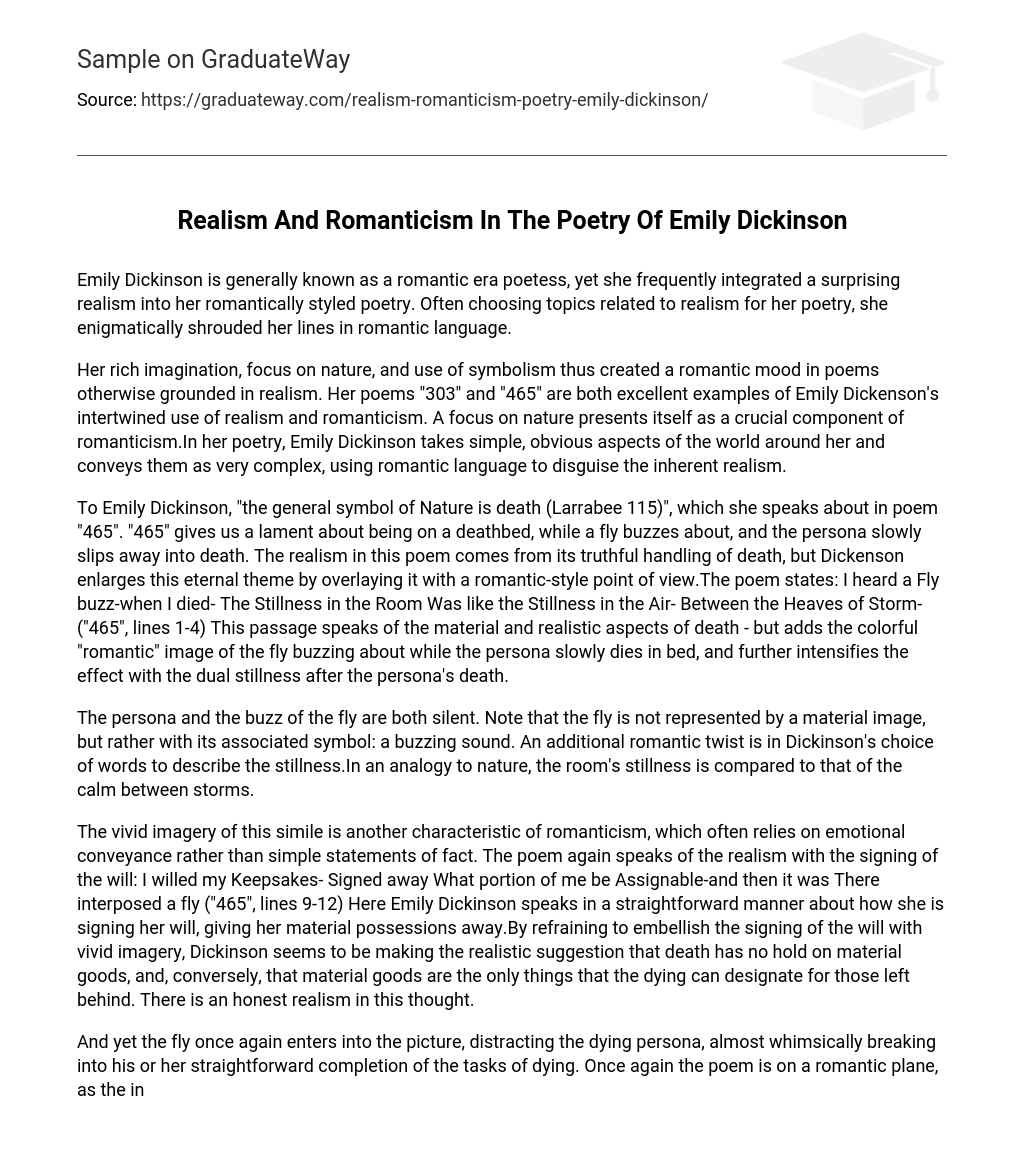Emily Dickinson is generally known as a romantic era poetess, yet she frequently integrated a surprising realism into her romantically styled poetry. Often choosing topics related to realism for her poetry, she enigmatically shrouded her lines in romantic language.
Her rich imagination, focus on nature, and use of symbolism thus created a romantic mood in poems otherwise grounded in realism. Her poems “303” and “465” are both excellent examples of Emily Dickenson’s intertwined use of realism and romanticism. A focus on nature presents itself as a crucial component of romanticism.In her poetry, Emily Dickinson takes simple, obvious aspects of the world around her and conveys them as very complex, using romantic language to disguise the inherent realism.
To Emily Dickinson, “the general symbol of Nature is death (Larrabee 115)”, which she speaks about in poem “465”. “465” gives us a lament about being on a deathbed, while a fly buzzes about, and the persona slowly slips away into death. The realism in this poem comes from its truthful handling of death, but Dickenson enlarges this eternal theme by overlaying it with a romantic-style point of view.The poem states: I heard a Fly buzz-when I died- The Stillness in the Room Was like the Stillness in the Air- Between the Heaves of Storm- (“465”, lines 1-4) This passage speaks of the material and realistic aspects of death – but adds the colorful “romantic” image of the fly buzzing about while the persona slowly dies in bed, and further intensifies the effect with the dual stillness after the persona’s death.
The persona and the buzz of the fly are both silent. Note that the fly is not represented by a material image, but rather with its associated symbol: a buzzing sound. An additional romantic twist is in Dickinson’s choice of words to describe the stillness.In an analogy to nature, the room’s stillness is compared to that of the calm between storms.
The vivid imagery of this simile is another characteristic of romanticism, which often relies on emotional conveyance rather than simple statements of fact. The poem again speaks of the realism with the signing of the will: I willed my Keepsakes- Signed away What portion of me be Assignable-and then it was There interposed a fly (“465”, lines 9-12) Here Emily Dickinson speaks in a straightforward manner about how she is signing her will, giving her material possessions away.By refraining to embellish the signing of the will with vivid imagery, Dickinson seems to be making the realistic suggestion that death has no hold on material goods, and, conversely, that material goods are the only things that the dying can designate for those left behind. There is an honest realism in this thought.
And yet the fly once again enters into the picture, distracting the dying persona, almost whimsically breaking into his or her straightforward completion of the tasks of dying. Once again the poem is on a romantic plane, as the insistent fly again is represented using its sound rather than its physical being.The poem closes with the juxtaposition of sound and fading light, as Emily Dickenson’s last stanza in poem “465” reads; With Blue-uncertain stumbling Buzz- Between the light-and me- And then the Windows failed-and then I could not see to see- (“465”, 13-16) Throughout the entirety of the poem, Dickinson focuses on the individual, a critical part of romanticism. Although possessions are willed away, there is no mention of another person present with the sole persona.
Emily Dickenson writes “465” in the first person, helping the reader identify with the individual.She writes in “465” how “I heard a fly buzz (“465, line 1)”, and “Between the light-and me-(“465″, line 14),” and repeatedly uses the words “I” and “me”, maintaining the focus upon her individual and very personal actions and thoughts. Dickinson also incorporates another aspect of romanticism, nostalgia, by writing “465” from the perspective of a persona who is reflecting on his or her death and remembering the past. Sharon Cameron states, “We must imagine the speaker looking back on an experience in which her expectations of death were foiled by its reality (Cameron 65).
In Emily Dickinson’s “303”, she speaks about the soul and the self, both qualities tied to romanticism. The entire poem is riddled in symbolism; in fact, little of the poem is not symbolic. Emily Dickinson writes in “303”: The Soul selects her own Society- Then-shuts the Door- To her divine Majority- Present no More- Unmoved-she notes the Chariots-pausing At her Low Gate- Unmoved-an Emperor be kneeling Upon her Mat- (“303” lines 1-8) She speaks about the power of self and soul.The soul is personified, given “living.
.. pace defined by door, gate, and mat (Juhasz 105),” while all external authorities are kept outside. Dickinson’s heavy use of symbolism implies that the soul has power, and that it is a society in itself.
Dickinson writes how the soul has the ability to make its own world, and that “ability to construct a world for oneself comprises the greatest power, a god-like achievement (Juhasz 106). ” Emily Dickinson’s “303”, filled with classical images of royalty and divinity, romantically describes her view of the individuality and, in a way, the supremacy of one’s soul.As can be seen in the preceding examples, much of the power of Emily Dickinson’s poetry comes from her use of this combination of the poetic styles of romanticism and realism. She uses a style of writing that combines raw emotional power, individualism, and the symbolism of romanticism with the truthfulness of material subjects and ordinary life topics of realism.
Her genius is in inviting the reader to share with her these familiar topics, and then offering them in a romanticist package which is surprising, fanciful and perceptive all at once.





